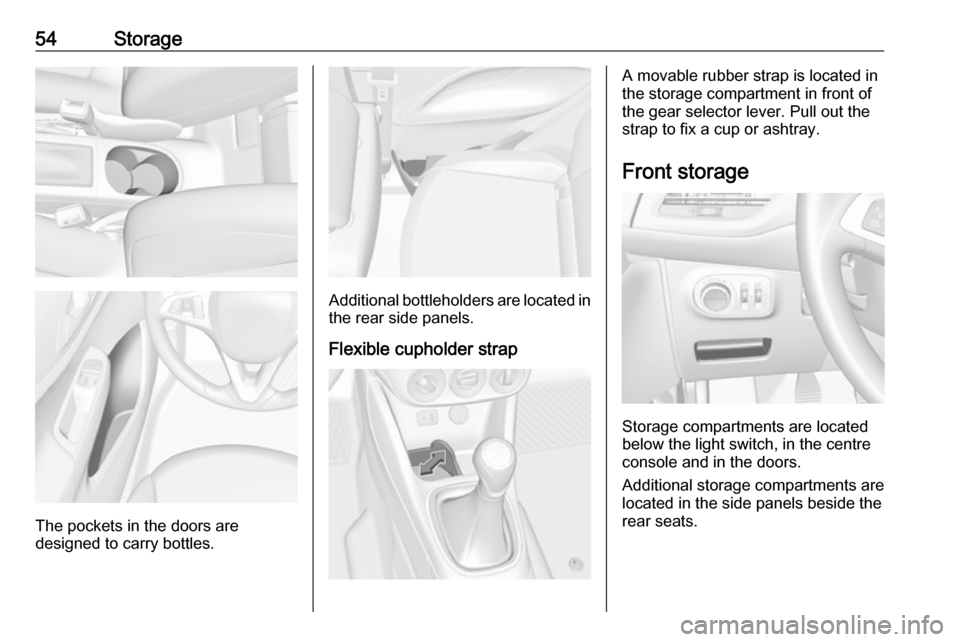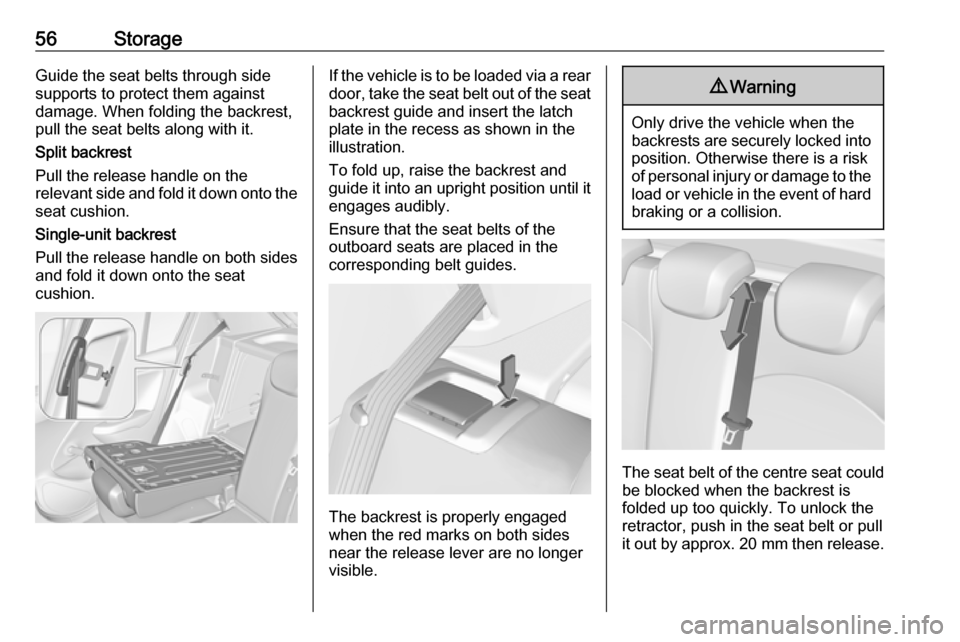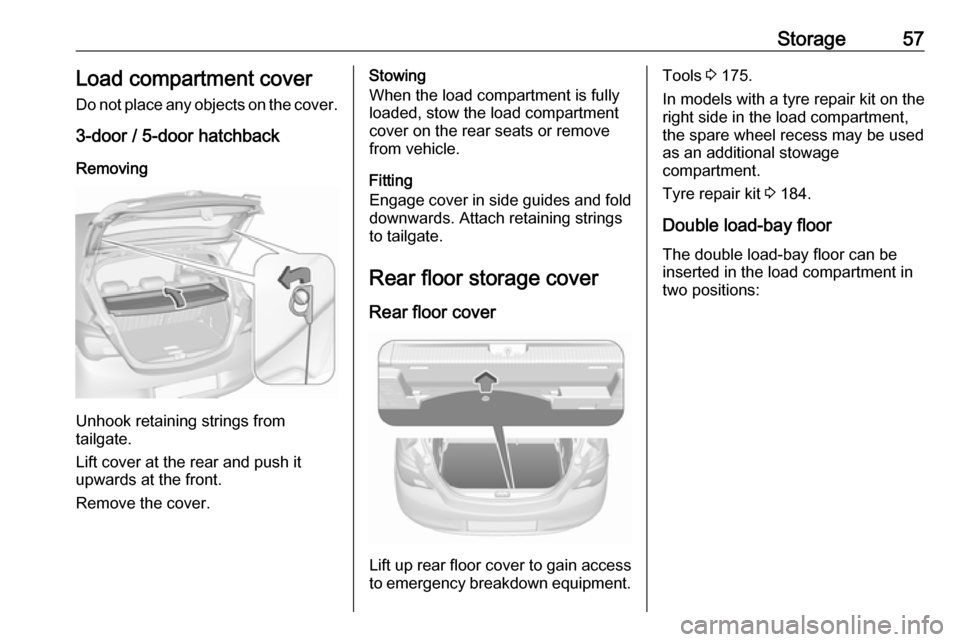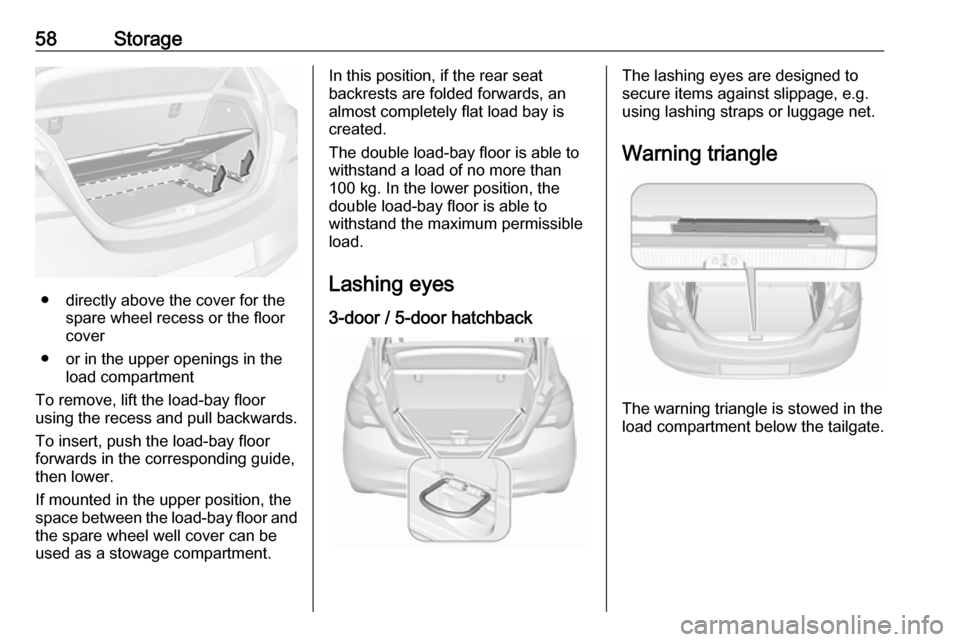VAUXHALL CORSA F 2019 Workshop Manual
Manufacturer: VAUXHALL, Model Year: 2019, Model line: CORSA F, Model: VAUXHALL CORSA F 2019Pages: 229, PDF Size: 6.72 MB
Page 51 of 229

Seats, restraints49Notice
Do not affix anything on the child
restraint systems and do not cover
them with any other materials.
A child restraint system which has
been subjected to stress in an
accident must be replaced.
Page 52 of 229

50Seats, restraintsChild restraint installation locations
Permissible options for fastening a child restraint system with a three-point seat belt
Weight class
On front passenger seat
On rear outboard seatsOn rear centre seat
activated airbagdeactivated airbagGroup 0: up to 10 kgXU 1,2U/L 3XGroup 0+: up to 13 kgXU1,2U/L 3XGroup I: 9 to 18 kgXU1,2U/L 3,4XGroup II: 15 to 25 kgU1,2XU/L 3,4XGroup III: 22 to 36 kgU1,2XU/L 3,4XU:universal suitability in conjunction with three-point seat beltL:suitable for particular child restraint systems of the 'specific-vehicle', 'restricted' or 'semi-universal' categories. The
child restraint system must be approved for the specific vehicle type (refer to the vehicle type list of the child restraint
system)X:no child restraint system permitted in this weight class1:move seat forwards as far as necessary and adjust seat backrest as far as necessary to a vertical position to ensure that the belt runs forwards from the upper anchorage point2:move seat upwards as far as necessary and adjust seat backrest as far as necessary to a vertical position to ensurethat the belt is tight on the buckle side3:move the respective front seat ahead of the child restraint system forwards as far as necessary4:adjust the respective backrest to the rearmost position 3 55 , adjust the respective headrest as necessary or remove
if required 3 32
Page 53 of 229

Seats, restraints51Permissible options for fitting an ISOFIX child restraint system
Weight classSize classFixture
On front passenger seat5On rear outboard
seatsOn rear centre
seatactivated airbagdeactivated airbagGroup 0: up to 10 kgEISO/R1XILIL 3XGroup 0+: up to 13 kgEISO/R1XILIL3XDISO/R2XILIL3XCISO/R3XILIL3XGroup I: 9 to 18 kgDISO/R2XILIL3,4XCISO/R3XILIL 3,4XBISO/F2XIL/IUFIL, IUF 3,4XB1ISO/F2XXIL/IUFIL, IUF3,4XAISO/F3XIL/IUFIL, IUF3,4XGroup II: 15 to 25 kgIL1,2XIL3,4XGroup III: 22 to 36 kgIL 1,2XIL3,4XIL:suitable for particular
ISOFIX restraint systems of the "specific-vehicle", "restricted" or "semi-universal" categories.
(ISOFIX / Top-tether fastening points optional for the front passenger seat but not available for sport seats). The ISOFIX restraint system must be approved for the specific vehicle type (refer to the vehicle type list of the child
restraint system)IUF:suitable for ISOFIX forward-facing child restraint systems of universal category approved for use in this weight class
(ISOFIX / Top-tether fastening points optional for the front passenger seat but not available for sport seats)
Page 54 of 229

52Seats, restraintsX:no ISOFIX child restraint system approved for this weight class1:move seat forwards as far as necessary and adjust seat backrest as far as necessary to a vertical position to ensure
that the belt runs forwards from the upper anchorage point2:move seat upwards as far as necessary and adjust seat backrest as far as necessary to a vertical position to ensure
that the belt is tight on the buckle side3:move the respective front seat ahead of the child restraint system forwards as far as necessary4:adjust the respective backrest to the rearmost position 3 55, adjust the respective headrest as necessary or
remove if required 3 325:ISOFIX / Top-tether fastening points optional for the front passenger seat (not available for sport seats)
ISOFIX size class and seat device
A – ISO/F3:forward-facing child restraint system for children of maximum size in the weight class 9 to 18 kgB – ISO/F2:forward-facing child restraint system for smaller children in the weight class 9 to 18 kgB1 – ISO/F2X:forward-facing child restraint system for smaller children in the weight class 9 to 18 kgC – ISO/R3:rear-facing child restraint system for children of maximum size in the weight class up to 18 kgD – ISO/R2:rear-facing child restraint system for smaller children in the weight class up to 18 kgE – ISO/R1:rear-facing child restraint system for young children in the weight class up to 13 kg
Page 55 of 229

Storage53StorageStorage compartments................53
Glovebox ................................... 53
Cupholders ................................ 53
Front storage ............................. 54
Underseat storage .....................55
Load compartment .......................55
Load compartment cover ...........57
Rear floor storage cover ............57
Lashing eyes ............................. 58
Warning triangle ........................58
First aid kit ................................. 59
Roof rack system .........................59
Roof rack ................................... 59
Loading information .....................59Storage compartments9Warning
Do not store heavy or sharp
objects in the storage
compartments. Otherwise, the
storage compartment lid could
open and vehicle occupants could be injured by objects being thrown
around in the event of hard
braking, a sudden change in
direction or an accident.
Glovebox
Pull lever to open the glovebox cover.
The glovebox features a coin holder.
The glovebox features an adapter for
the locking wheel bolts.
The glovebox should be closed whilst driving.
Cupholders
Cupholders are located in the centre
console.
Page 56 of 229

54Storage
The pockets in the doors are
designed to carry bottles.
Additional bottleholders are located in the rear side panels.
Flexible cupholder strap
A movable rubber strap is located in
the storage compartment in front of
the gear selector lever. Pull out the
strap to fix a cup or ashtray.
Front storage
Storage compartments are located
below the light switch, in the centre
console and in the doors.
Additional storage compartments are
located in the side panels beside the
rear seats.
Page 57 of 229

Storage55Underseat storage
Lift at recessed edge and pull out.
Maximum load: 1.5 kg. To close, push in and engage.
Load compartment
Load compartment extension
The rear backrest can be locked in
two positions. When transporting
bulky items, lock in an upright
position.
Split backrest
Pull the release handle on the
relevant side, pull the backrest
forwards to the vertical position and engage.
Single-unit backrest
Pull the release handle on both sides,
pull the backrest forwards to the
vertical position and engage.
When unlocking, a red marking
appears next to the release lever. The backrest is properly engaged when
the red marks on both sides near the release lever are no longer visible.
Folding down rear backrests Remove load compartment cover as
necessary.
Push head restraints down by
pressing the catch.
Page 58 of 229

56StorageGuide the seat belts through side
supports to protect them against
damage. When folding the backrest,
pull the seat belts along with it.
Split backrest
Pull the release handle on the
relevant side and fold it down onto the seat cushion.
Single-unit backrest
Pull the release handle on both sides
and fold it down onto the seat
cushion.If the vehicle is to be loaded via a rear
door, take the seat belt out of the seat
backrest guide and insert the latch
plate in the recess as shown in the
illustration.
To fold up, raise the backrest and
guide it into an upright position until it engages audibly.
Ensure that the seat belts of the
outboard seats are placed in the corresponding belt guides.
The backrest is properly engaged
when the red marks on both sides
near the release lever are no longer
visible.
9 Warning
Only drive the vehicle when the
backrests are securely locked into position. Otherwise there is a risk
of personal injury or damage to the
load or vehicle in the event of hard braking or a collision.
The seat belt of the centre seat could
be blocked when the backrest is
folded up too quickly. To unlock the
retractor, push in the seat belt or pull
it out by approx. 20 mm then release.
Page 59 of 229

Storage57Load compartment cover
Do not place any objects on the cover.
3-door / 5-door hatchback
Removing
Unhook retaining strings from
tailgate.
Lift cover at the rear and push it
upwards at the front.
Remove the cover.
Stowing
When the load compartment is fully
loaded, stow the load compartment
cover on the rear seats or remove
from vehicle.
Fitting
Engage cover in side guides and fold
downwards. Attach retaining strings
to tailgate.
Rear floor storage coverRear floor cover
Lift up rear floor cover to gain access
to emergency breakdown equipment.
Tools 3 175.
In models with a tyre repair kit on the
right side in the load compartment,
the spare wheel recess may be used
as an additional stowage
compartment.
Tyre repair kit 3 184.
Double load-bay floor The double load-bay floor can be
inserted in the load compartment in
two positions:
Page 60 of 229

58Storage
● directly above the cover for thespare wheel recess or the floor
cover
● or in the upper openings in the load compartment
To remove, lift the load-bay floor
using the recess and pull backwards.
To insert, push the load-bay floor
forwards in the corresponding guide,
then lower.
If mounted in the upper position, the
space between the load-bay floor and
the spare wheel well cover can be
used as a stowage compartment.
In this position, if the rear seat
backrests are folded forwards, an
almost completely flat load bay is
created.
The double load-bay floor is able to
withstand a load of no more than
100 kg. In the lower position, the
double load-bay floor is able to
withstand the maximum permissible
load.
Lashing eyes 3-door / 5-door hatchbackThe lashing eyes are designed to
secure items against slippage, e.g.
using lashing straps or luggage net.
Warning triangle
The warning triangle is stowed in the
load compartment below the tailgate.